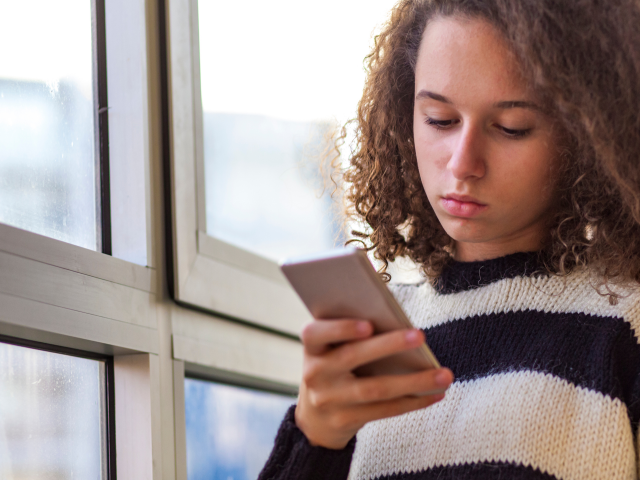Do you ever feel like your smartphone is a third party to your relationships? Research shows that Millennials and Gen Z communicate more often digitally (65%) than in person, a trend that has continued to pick up momentum in our increasingly digital world.
It makes sense when you consider how easy it is today to catch up with a friend or let your partner know you are thinking of them from miles away. But leaning too heavily on digital communication — conversation that happens online and in apps (text, email, social media, dating apps, etc.) — can be detrimental to our relationships and overall well-being. So how do we know what works well in your relationship and when to cut the cord?
Here are a few things to consider when determining how often to communicate digitally.
Define your digital boundaries

Boundaries are the limits we set to create a healthy sense of personal space. When boundaries are set in a relationship, each partner is telling the other what they are comfortable with and how they prefer to be treated. In the digital space, boundaries help us strike a balance in how often we engage with someone. Our digital devices give us virtually unlimited access to others, but going overboard isn’t healthy for us or the person on the receiving end.
To define your digital boundaries, consider your comfort level with the quantity and quality of in-app conversations. Do you have a general limit on how many hours per day you spend on your phone? On social media? Certain times you won’t check it? How about during busier days or weeks? Are there types of conversations you won’t have through an app or over text?
Once you understand your limits, consider those of your friends, partners, and dating interests. Some boundaries may be clear even if unspoken, but most do well when formally set and discussed. Healthy digital communication looks like all parties in a relationship respecting each other’s needs and limits.
Consider the relationship

Different relationships will call for different levels of digital communication. Your best friend might respond differently to a 1 AM text than a new romantic fling. You and your long-distance S/O might appreciate a back-and-forth of IG memes throughout the day. Or maybe you expect your partner to respect your space while you each go about your daily responsibilities and save online engagement for times when you can both be fully present.
Like most things, your approach to digital communication should be tailored to your relationship. Talk to those on the receiving end and ask what works best for them. And know that it’s normal for your preferences to change as you and your relationships develop.
Knowing when to cut the cord

It’s not uncommon to struggle with digital communication overload. Boundaries, those we set with ourselves and with others, can be diluted in the murky waters of the digital world. But it’s important to take note of the negative consequences of too much digital communication.
Do you ever find that you miss every word your friend just said because you were engrossed in checking a text? Does your school work ever suffer because you just can’t stop checking your partner’s social media feeds? When we focus so much of our energy on the virtual world, we risk neglecting in-person connection.
Moreover, too much digital communication can put serious distance between us and those on the other line. For example, disturbing someone at work or in the middle of the night might not always be a welcome interaction. Inundating someone on a social app or asking too many imposing questions about where someone is, what they are doing, and who they’re with can feel overwhelmingly intense or even unsafe.
Lastly, some conversations can be more beneficial face-to-face. Serious arguments and other sensitive topics like breakups or sexual intimacy usually fit in here. Unhealthy amounts of digital communication when it comes to these sorts of discussions can even lead to unwanted text anxiety and miscommunication.

Bottom line: There is no one-size-fits-all when it comes to how much digital communication is right in a relationship. Take time for personal reflection and talk to your partner. One tool that can be helpful is setting up limits on social media apps using your phone’s Screen Time function. You can also try writing down a list of shared phone rules as a date night activity, or making a pact with a trusted friend to hold onto your phone if you feel the urge to start text bombing. And always seek help if you feel overwhelmed on the receiving end of someone else’s unhealthy digital behavior.
If you or someone you know is experiencing an unhealthy or abusive relationship, check out our real-time resources, or call the National Domestic Violence Hotline at 1-800-799-7233. If you’re in imminent danger, please call 911
Browse by Category

Don’t Be on the Naughty List: Spotting Unhealthy Relationship Signs This Holiday Season
The holidays are meant for joy, connection, and celebration—whether it’s Christmas, Hanukkah, Kwanzaa, or cozy winter vibes. But if someone…
How to Have Healthy Holiday Conversations with Family (and Prep Your Partner)
The holidays are a time for family, good food, and—let's…
Finding Strength in Our Stories: Domestic Violence Awareness Month
⚠️ Trigger Warning: This blog includes content and language related…
Understanding Domestic Violence Awareness Month (DVAM)
October is almost here, and that means it’s time to…
4 Students Share How They Helped a Friend in an Unhealthy Relationship
Watching a friend struggle in an unhealthy or abusive relationship…














